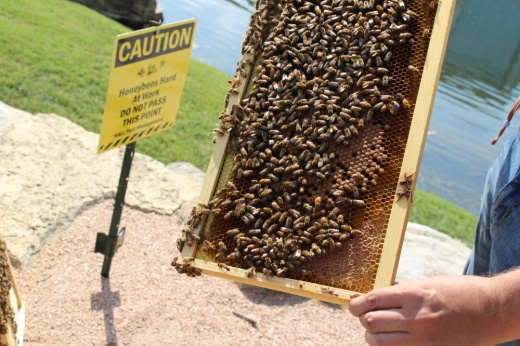“The winter storm caused delayed wildflower bloom and that certainly impacted honey production,” said Molly Keck, AgriLife Extension entomologist and Beekeeping 101 instructor, in a press release. “It likely caused honey bee losses, especially in South Texas where bees are not acclimated to that type of freezing cold.”
Drought conditions in early spring also negatively affected honey production, Keck said, though comprehensive honey production data for 2021 will not be available until spring 2022.
Data released by the U.S. Department of Agriculture in March shows national honey production dropped from 157 million pounds in 2019 to 148 million pounds in 2020.
In Texas, production rose slightly from 7.56 million pounds in 2019 to 8.95 million pounds in 2020, and the USDA reported the number of honey-producing colonies increased to 157,000 in the state, compared to 126,000 in 2019.
A survey by the national nonprofit Bee Informed Partnership reported record-high colony losses statewide for the 2020-21 season, which ran from March 2020 to April 2021.
“This was a historically bad year for honey production overall,” Charlie Bee Co. owner Charlie Agar said.
Agar specializes in bee removal throughout Central Texas and relocates hives to ranch apiaries. He also maintains several of his own honey-producing hives.
“[The storm] was so bad that my small hives just ate up their stores, and they froze out,” he said. “My strong hives, my big, healthy hives, were not really adversely affected by the cold. In fact, they're made for that.”
Keck said honey production and hive health varied among hobbyists, small-scale producers and commercial producers, depending on regional weather changes, hive size and access to food sources during the winter.
Restrictions at the height of the pandemic likely gave part-time beekeepers more opportunity to give their hives attention, whereas commercial producers may have had issues with labor, Keck said.
“I think a lot of the results came down to local conditions—their colony health coming out of winter and any interventions beekeepers made to help their colonies along when they needed it,” she said.
For Agar, a late spring and wet summer made it difficult for his bees to find the forage, or food supply, they needed to produce higher volumes of honey.
“Pollen is their protein. ... Without that, they got off to a slow start,” Agar said. “The challenge to beekeepers in Texas isn't necessarily the cold winters. It's the lack of forage.”
September rains and warmer weather in some parts of the state provided a late bloom that Keck said is helping colonies stock away food stores to get them through the winter. But beekeepers should be monitoring colonies for any supplemental needs.
“Bees are much like livestock in that we are responsible to provide what nature is not providing,” she said. “In parts of the state, especially the Southern half, flowers may be blooming into December, but most hives are closed up at Thanksgiving and not opened back up until around Valentine’s Day.”
Jishnu Nair and Ally Bolender contributed to this report.





